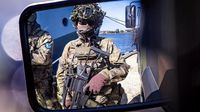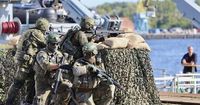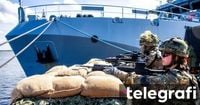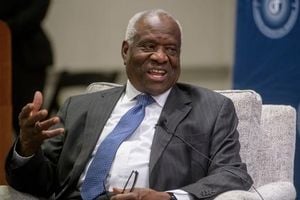In a striking display of military coordination and resolve, Germany has taken the lead in a sweeping NATO exercise, dubbed Quadriga 2025, amid mounting tensions with Russia on the alliance’s eastern flank. The operation, which began on September 4, 2025, centers on moving troops and heavy equipment to Lithuania—a NATO member that shares borders with Russia’s Kaliningrad exclave and Belarus, a close ally of Moscow. The multi-week exercise is being watched closely by both European allies and geopolitical observers, as it unfolds against the backdrop of the ongoing war in Ukraine and renewed fears of Russian aggression in the region.
On the opening day, the port of Rostock in northern Germany buzzed with activity and anticipation. German military leadership, ambassadors from the Baltic states, and senior officers from a host of other nations gathered to witness a ferry, brimming with military vehicles, setting sail for Klaipeda, Lithuania. The vessel was not alone—its journey was flanked by a police escort, a corvette, a minesweeper, and a helicopter, according to reporting from the Associated Press and Euronews. The scene was further enlivened by Eurofighter jets roaring overhead and military experts demonstrating the interception of drones both in the air and on the water.
Quadriga 2025 is under the command of the German navy, with robust participation from the country’s army and air force. In total, the exercise involves more than 8,000 military personnel drawn from 14 countries. These include every NATO nation with a Baltic Sea coastline—such as Estonia, Latvia, Lithuania, Poland, and Denmark—alongside key alliance members like the United States, United Kingdom, France, and Canada. The German military has confirmed the deployment of 40 ships, 20 aircraft, and more than 1,800 road vehicles for the operation, an impressive logistical feat by any standard.
The rationale for such a large-scale exercise is clear: to demonstrate, in concrete terms, NATO’s readiness and ability to defend its eastern members against any external threat. As a spokesperson for the Quadriga Media Information Centre told Euronews, the manoeuvre "demonstrates the determination, capability and willingness of Germany and its allies to defend their territory and NATO territory against any external attack."
General Carsten Breuer, Chief of Staff of the German military, underscored the importance of the exercise during a press briefing at Rostock. "We are seeing close up today what it means in concrete terms when Germany takes international responsibility," he said, describing his country as a "reliable supply hub for NATO." He added, "Almost all supply routes to the eastern flank go via Germany." These remarks highlight Germany’s pivotal logistical role within NATO, particularly as the alliance shifts its focus to deterrence and rapid reinforcement in the east.
The context for Quadriga 2025 is anything but routine. Since Russia’s full-scale invasion of Ukraine in 2022, NATO has been urgently reassessing its posture and capabilities along its eastern borders. Lithuania, the destination for much of the exercise’s troop and equipment movements, sits at a strategic crossroads—bordering both Kaliningrad, a heavily militarized Russian enclave, and Belarus, which has hosted Russian forces and joint exercises. In May 2025, Germany took the significant step of inaugurating a permanent brigade in Lithuania, a move widely interpreted as a direct response to heightened concerns about Russian intentions in the region.
General Breuer has been candid about the threat environment facing NATO. Earlier in the week, as reported by the BBC and Euronews, he stated, "The threat remains unchanged, both hybrid and conventional. Putin is watching us, and his plans go far beyond Ukraine. As armed forces, we must prepare ourselves for this." His words echo a growing consensus among Western military planners that the risk of escalation—or at the very least, increased hybrid activity—remains high as the conflict in Ukraine drags on.
Yet, Breuer and other German officials have been careful to balance this message of vigilance with a call for restraint. "We want deterrence, we don’t want escalation," he stressed, emphasizing NATO’s defensive posture. He also warned that Moscow could use its own upcoming military exercise, known as Zapad (Russian for "West"), to stoke insecurity and justify further aggressive rhetoric. Zapad, a regular Russian-Belarusian joint drill, is scheduled to take place later this month and is expected to involve more than 13,000 troops. While Quadriga and Zapad will overlap in timing, they will not coincide geographically—a detail that has not gone unnoticed by military analysts wary of unintended incidents or miscalculations.
Germany’s leadership in Quadriga 2025 also reflects a broader shift in its defense policy. After years of underinvestment and what some critics have called "neglect," Berlin is now moving to strengthen its military capabilities. The German cabinet recently backed a draft bill aiming to boost the Bundeswehr’s ranks from 182,000 to 260,000 by the early 2030s. This ambitious plan comes as Berlin, like other NATO capitals, seeks to reassure both its own citizens and its allies that it is ready to meet its commitments in a more uncertain security environment.
The display of unity in Rostock was not just for show. The presence of ambassadors from the Baltic states and officers from across the alliance sent a clear signal of solidarity. As one senior officer put it, "This is not just about Germany or Lithuania, but about the collective security of all NATO members." The choreography of ships, aircraft, and ground vehicles underscored the logistical complexity of reinforcing the alliance’s eastern front—a capability that would be vital in the event of any real-world crisis.
Military experts who observed the drone interception demonstrations noted the growing importance of counter-drone technology in modern warfare. With the proliferation of unmanned aerial vehicles on battlefields from Ukraine to the Middle East, NATO forces are investing heavily in both detection and neutralization systems. The Eurofighter flyovers, meanwhile, served as a potent reminder of the alliance’s airpower and rapid response capabilities.
Quadriga 2025 will continue for several weeks, with further movements and exercises planned across the region. The eyes of both allies and adversaries will remain trained on the Baltic, as NATO seeks to project strength without provoking unnecessary escalation. For Germany, the exercise marks a new chapter in its role as both a logistical linchpin and a frontline contributor to European security.
As the ferry disappeared over the horizon, bound for Lithuania under heavy escort, the message from Rostock was unmistakable: NATO is watching, ready, and united—determined to defend its eastern borders, come what may.






